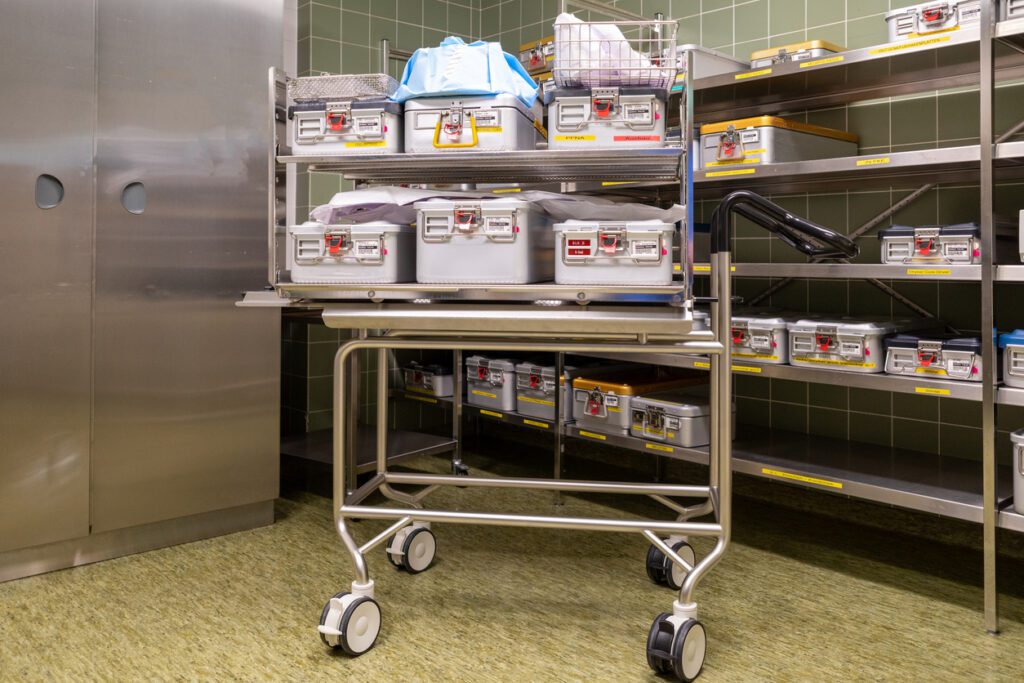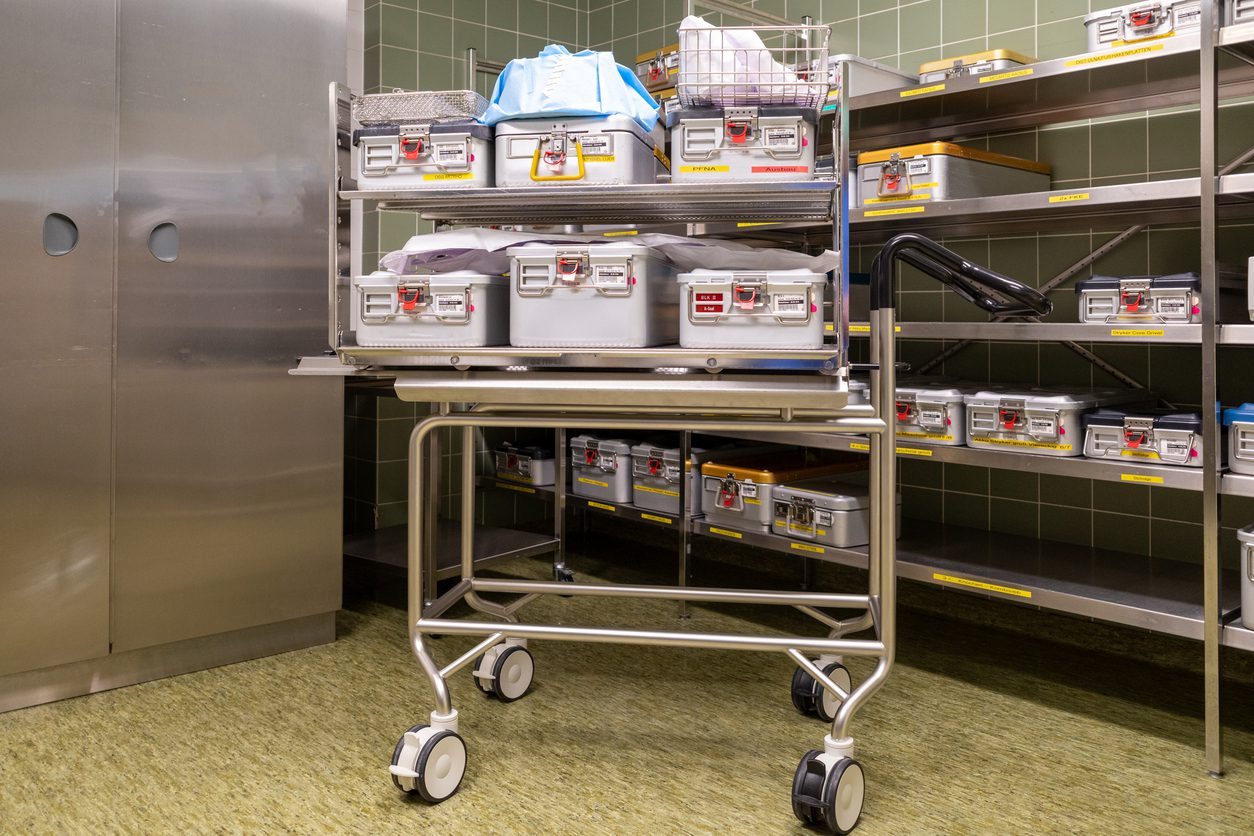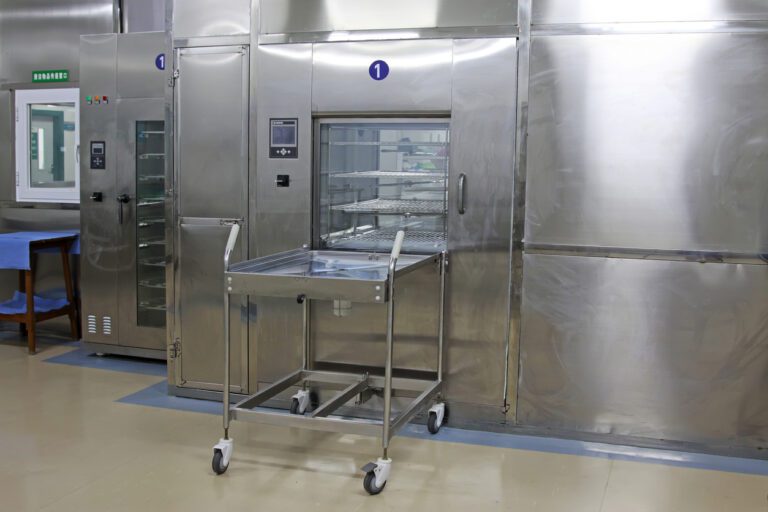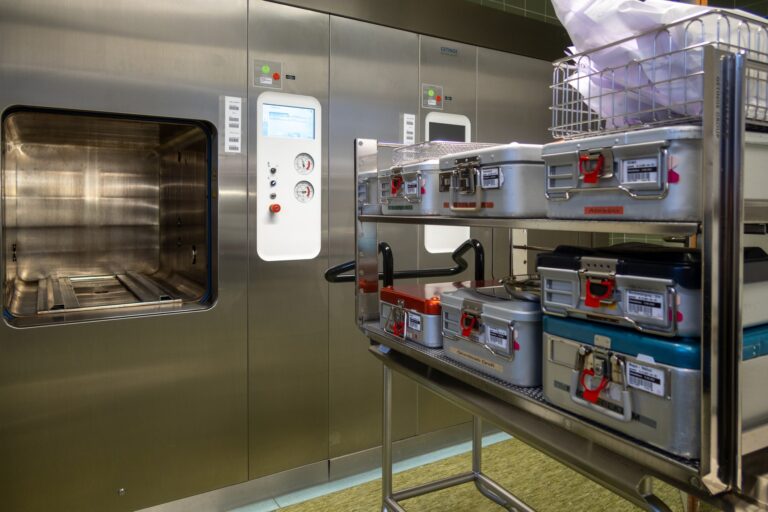
Hospital sterilization, which uses sterilizers, is of utmost importance in hospitals to ensure the safety and well-being of patients. This process involves decontamination to ensure that all equipment and instruments are free from harmful bacteria or viruses. With numerous innovative technologies available, it can be overwhelming to determine the best hospital sterilization techniques and their effects.
Proper sterilization using a sterilizer is crucial for preventing the spread of infections and diseases within healthcare facilities. By implementing rigorous sterilization practices and using sterilizers and disinfectants, hospitals can significantly reduce the risk of cross-contamination. This helps protect both patients and healthcare workers by ensuring that all equipment and surfaces are properly decontaminated.
Table of Contents
- 0.1 A Guide to Hospital Sterilization
- 0.2 Effectiveness of different Sterilization methods
- 0.3 How to Decrease the Incidence of Infections during Healthcare Procedures
- 0.4 Risks of Improper Sterilization: Health Care-Associated Infections
- 0.5 Understanding Ethylene Oxide (ETO) Sterilization and Its Benefits
- 0.6 Vaporized Hydrogen Peroxide (VHP) Sterilization: An Effective Method
- 0.7 Here are some key points to consider about VHP® sterilization:
- 0.8 Steam Sterilization Equipment
- 0.9 Preventing Hospital-Acquired Infections in Intensive Care Units and Operating Rooms
- 0.10 Cleaning and Disinfecting Surfaces and Floors in Healthcare Facilities
- 0.11 Preferred Methods for Sterilizing Various Medical Devices
- 0.12 Infections in Operating Rooms and Intensive Care Units
- 0.13 Conclusion
- 0.14 Frequently Asked Questions?
- 0.14.1 What is the most cost-effective sterilization method?
- 0.14.2 Are there any risks associated with improper sterilization?
- 0.14.3 How often should medical instruments be reprocessed?
- 0.14.4 Can I use household disinfectants to clean surfaces in healthcare facilities?
- 0.14.5 What considerations should be made when designing operating rooms and intensive care units?
- 1 Subscribe to our Newsletter
A Guide to Hospital Sterilization
Following industry standards for sterilization is crucial in maintaining the safety and cleanliness of medical equipment. Using a sterilizer or autoclave ensures that equipment is properly decontaminated with sterile water.
However, it is equally important to understand the significance of disinfection and decontamination as complementary processes in sterilization and cleaning. By implementing proper guidelines, hospitals can ensure the safety and effectiveness of their medical devices. These guidelines include preventive measures, procedures, and sterilization processes.
To achieve optimal sterilization results in healthcare facilities, hospitals must adhere to industry standards by using high-level disinfectants for medical devices. These standards provide a framework that ensures consistency and effectiveness in the cleaning and sterilization procedures of medical devices.
Use High-Level Disinfectants for the best Sterilization Techniques
In the process of hospital sterilization techniques, it is extremely important to utilize a high-level disinfectant. To ensure the complete elimination of harmful microorganisms from medical equipment, healthcare facilities should adhere to specific protocols and procedures. One highly effective sterilization method involves utilizing radiation sterilization.
Radiation is a safe and cost-effective method for sterilizing single-use medical devices such as syringes and surgical gloves. One of its key advantages is that it allows already-packaged products to be sterilized. This method requires placing the equipment in a sterilization chamber and subjecting it to radiation, which guarantees a thorough sterilization process.
One key aspect of following industry standards is utilizing appropriate Sterilization methods for medical devices based on the type of equipment being sterilized. Different techniques, such as steam autoclaving, ethylene oxide gas sterilization, or plasma discharge, may be recommended for disinfecting medical devices, such as endoscopes, depending on their nature.
Understanding the Importance of Disinfection
While cleaning focuses on reducing the number of microorganisms to a safe level, disinfection aims to kill them using chemical sterilization. Disinfecting medical equipment using a sterilization method is crucial for preventing the spread of infectious diseases within healthcare settings. Disinfectant involves using chemical agents or other means to destroy or inhibit the growth of pathogens on surfaces during cleaning. This process is especially important for preventing infections and maintaining the safety of medical devices.
Proper cleaning and disinfection is particularly important for medical devices and objects that cannot withstand high-temperature sterilization methods or come into contact with intact skin rather than sterile body tissues. Examples include stethoscopes, blood pressure cuffs, and examination tables.
Implementing Guidelines for Equipment Safety
Hospitals should establish comprehensive guidelines for cleaning and sterilizing endoscopes to ensure the safety of medical devices used in health care. These guidelines should cover various aspects, such as
- Thoroughly cleaning medical devices, such as endoscopes, before any further processing is essential to remove organic material that may interfere with subsequent steps and reduce the risk of infection.
- Packaging: Proper packaging protects medical devices during storage and transportation in the healthcare industry while maintaining sterility until they are needed for cleaning.
- Regular monitoring of sterilization equipment and processes is crucial for ensuring the effectiveness of cleaning and sterilization.
- Training: Proper training is a vital component that should be provided to healthcare staff involved in the sterilization process.
Effectiveness of different Sterilization methods
Various methods are available. Each method differs in its compatibility with different types of medical devices, the technology employed for cleaning, and the effects it has on the items and objects being sterilized.
One commonly used method is steam sterilization, also known as autoclaving, to prevent infection in the health care setting. This cleaning method utilizes high-pressure steam to effectively kill microorganisms on medical devices, reducing the risk of infection in healthcare settings.
It is highly effective in achieving sterility for medical devices, to prevent infection. The sterilization process is compatible with a wide range of materials. However, it may not be suitable for sterilizing heat-sensitive medical devices or those that can be damaged by moisture, which is crucial for infection control in healthcare settings.
Another method worth considering is ethylene oxide (EO) sterilization. EO gas is a highly effective method for cleaning and disinfecting devices in the healthcare industry. It penetrates packaging materials and eliminates infection-causing microorganisms by damaging their DNA.
It is highly effective for infection control and can be used to care for a broad spectrum of pathogens. EO is particularly useful for heat-sensitive items such as plastic devices or electronic components.
For hospitals looking to quickly and efficiently sterilize their devices and ensure proper infection care, hydrogen peroxide gas plasma sterilization could be an excellent cleaning option. This method uses low-temperature hydrogen peroxide gas plasma to kill microorganisms on medical devices, ensuring infection control and proper care. It is compatible with a wide range of materials and has a relatively short cycle time compared to other sterilizing methods.
Considering the cost implications
In addition to evaluating the effectiveness of different cleaning and sterilization methods, hospitals must also consider the cost implications associated with each option. Some methods may require significant upfront investments in specialized cleaning devices or infrastructure modifications, while others may have ongoing costs related to consumables or maintenance care.
Steam sterilization is a cost-effective method for cleaning and sterilizing devices. Autoclaves are widely available and affordable, making them popular for infection prevention and care. The operating costs mainly depend on water consumption, energy usage, regular maintenance requirements, cleaning, care, devices, and infection.
Ethylene oxide sterilization typically requires dedicated chambers equipped with safety measures for cleaning devices due to the flammable nature of the gas. Taking care to prevent infection is important during this process. The upfront cost of installing EO sterilizers and ensuring proper ventilation can be substantial for cleaning and preventing infection. When considering the cost of sterilization, it is important to take into account the purchase of ethylene oxide cartridges or cylinders and monitor their levels to prevent infection.
How to Decrease the Incidence of Infections during Healthcare Procedures
Preventive measures, including sterilization methods, are crucial in minimizing infections in healthcare settings. By implementing innovative ways to enhance patient safety, hospitals can significantly reduce the risk of healthcare-associated infections through cleaning and sterilization. This section will discuss strategies hospitals can employ to achieve infection control goals.
Hand Hygiene and Proper Sterilization
One of the most fundamental preventive measures in hospitals is ensuring proper hand hygiene for cleaning and preventing infection. The simple act of cleaning and washing hands with soap and water or using alcohol-based hand sanitizers can effectively reduce the transmission of harmful pathogens and prevent infection. Hospital staff should be well-trained in the importance of regular handwashing for cleaning, preventing infection, and adhering to strict protocols.
In addition to hand hygiene, proper sterilization techniques are vital for preventing infections. Hospitals must follow stringent hand hygiene practices. Autoclaving, ethylene oxide gas sterilization, and hydrogen peroxide plasma sterilization are used to ensure that equipment is free from harmful microorganisms and prevents infection.
Surveillance and Monitoring Systems
Implementing surveillance and monitoring systems is another essential aspect of hospital infection prevention. These systems help promptly identify any potential outbreaks or infection patterns within the facility. Hospitals can immediately mitigate the spread of infections by closely monitoring infection rates.
Surveillance systems often include routine tracking of various indicators, such as surgical site infections (SSIs), bloodstream infections (BSIs), urinary tract infections (UTIs), and ventilator-associated pneumonia (VAP). Hospital administrators can make informed decisions regarding infection control strategies by collecting accurate data on these key metrics.
Pilot Programs for Innovation
To stay ahead in the battle against healthcare-associated infections, many hospitals are embracing pilot programs to test innovative approaches. These programs allow hospitals to experiment with new technologies and protocols on a smaller scale before implementing them throughout the facility, reducing infection risk.
For example, hospitals may pilot using ultraviolet (UV) light disinfection systems to supplement traditional cleaning methods. These systems utilize UV-C light to kill bacteria and viruses on surfaces, providing additional protection against infections.
Risks of Improper Sterilization: Health Care-Associated Infections
Improper hospital sterilization practices can have serious consequences, leading to an increased risk of healthcare-associated infections. These infections occur when patients are exposed to microbial contamination due to inadequate sterilization procedures. The repercussions of such infections can be detrimental, not only for the patients but also for the healthcare workers involved.
One of the primary risks associated with improper sterilization is the transmission of infectious pathogens. When medical instruments and equipment are not properly sterilized, they can harbor microorganisms such as bacteria and viruses, leading to the risk of infection. These pathogens can then be transferred to patients during medical procedures, increasing the likelihood of infection.
Healthcare-associated infections pose a significant threat to patient safety. Patients who acquire these infections while receiving treatment in a hospital may experience prolonged recovery times, complications, and even mortality. This can lead to an erosion of trust between patients and healthcare providers, destroying the hospital’s reputation and increasing the risk of infection.
Significant Risk to Healthcare Staff
In addition to patients, healthcare workers are also at risk of infection when proper sterilization methods are not followed. They may come into contact with contaminated surfaces or equipment during their daily tasks, increasing their chances of contracting an infection themselves. This not only jeopardizes their own health but also puts them at risk of transmitting infections to other patients.
Improper sterilization practices can have legal implications for hospitals, especially when it comes to preventing infection. If a patient develops a healthcare-associated infection due to negligence in sterilization procedures, the hospital may face lawsuits and financial liabilities. Inadequate documentation or failure to adhere to established guidelines can further exacerbate legal consequences related to infection.
Implementing effective methods that guarantee sterility and eliminate microbial contamination is essential to mitigating the risks of infection and ensuring proper sterilization in hospitals.
Understanding Ethylene Oxide (ETO) Sterilization and Its Benefits
Ethylene Oxide (ETO) sterilization is a widely used method in hospitals to ensure the safety and cleanliness of medical instruments. This process involves exposing the instruments to ethylene oxide gas, eliminating various pathogens and microorganisms. ETO sterilization offers several benefits that make it a preferred choice in healthcare settings.
Explaining the Process and Benefits of ETO Sterilization
During ETO sterilization, medical instruments are placed within a sealed chamber and exposed to ethylene oxide gas. The gas penetrates through the packaging materials and reaches all surfaces of the instruments, ensuring thorough sterilization. This method is highly effective in killing bacteria, viruses, fungi, and spores that may be present on the instruments.
One of the significant advantages of ETO sterilization is its ability to penetrate complex shapes and materials. Unlike other methods that struggle with hard-to-reach areas or delicate equipment, ETO can easily disinfect even intricate devices. This makes it suitable for a wide range of medical instruments, including those with lumens or crevices that are difficult to clean manually.
ETO sterilization has proven to be highly effective against a broad spectrum of pathogens in healthcare environments. It can eliminate bacteria such as Staphylococcus aureus, Escherichia coli (E. Coli), and Pseudomonas aeruginosa. It is also effective against viruses like the hepatitis B virus (HBV), the immunodeficiency virus (HIV), and the influenza virus.
The versatility of ETO sterilization extends beyond bacteria and viruses; it also targets fungi like Candida albicans and Aspergillus niger. Moreover, this method efficiently destroys bacterial spores such as Clostridium difficile, ensuring high sterility for critical medical instruments.
Concerns Related to ETO’s Potential Hazards
ETO sterilization is great for complex tools that are hard to clean manually. However, careful is important because the gas can be toxic if not handled properly. Safety protocols, like good ventilation and monitoring of gas levels, need to be followed. After sterilization, the items should be aired to ensure there’s no leftover gas. Overall, ETO sterilization is effective, but safety precautions are necessary.
Vaporized Hydrogen Peroxide (VHP) Sterilization: An Effective Method
Vaporized Hydrogen Peroxide (VHP) sterilization is one of the top methods used in hospitals to ensure effective sterilization. This method utilizes the antimicrobial properties of hydrogen peroxide to eliminate a broad spectrum of microorganisms, including bacteria, viruses, and fungi.
One key advantage of VHP® sterilization is its compatibility with sensitive equipment. Unlike some other sterilization methods that can damage delicate instruments, VHP® does not leave behind any residue or pose a risk to the functionality or integrity of medical devices. This makes it ideal for sterilizing complex, intricate equipment such as endoscopes and robotic surgical instruments.
The effectiveness of VHP® sterilization lies in its ability to penetrate hard-to-reach areas and eliminate pathogens completely. The vaporized hydrogen peroxide reaches all enclosed surfaces, ensuring thorough disinfection. This is particularly important in healthcare settings, where contamination can occur in hidden crevices or narrow lumens.
Here are some key points to consider about VHP® sterilization:
Broad-Spectrum Antimicrobial Properties
-
- Vaporized hydrogen peroxide has been proven effective against many microorganisms, including antibiotic-resistant bacteria like MRSA.
-
- It has successfully decontaminated patient rooms, operating theaters, and sterile processing departments.
Compatibility with Sensitive Equipment
-
- VHP® does not damage delicate instruments or compromise their functionality.
-
- It is safe to use on materials such as plastics, metals, rubber, and electronics.
Thorough Disinfection
-
- The vapor penetrates even hard-to-reach areas within equipment or rooms.
-
- This ensures the complete elimination of pathogens that may be present on surfaces.
In addition to these advantages, VHP® sterilization offers other benefits such as rapid cycle times, low toxicity, and ease of use. However, it is important to note that VHP® sterilization may not be suitable for all types of equipment or materials.
Steam Sterilization Equipment
Steam sterilization is one of the most widely used methods for sterilizing hospital equipment. It involves high-pressure steam to kill bacteria, viruses, and other pathogens.
Sourcing Steam Sterilization Equipment
There are a few options available:
- Medical Supply Companies: Many medical supply companies specialize in providing equipment specifically designed for hospital settings. These companies offer a range of steam sterilization equipment that meets industry standards and regulations.
- Online Marketplaces: Online marketplaces like Amazon and eBay can be convenient options for purchasing steam sterilization equipment. However, ensuring that the seller is reputable and that the product meets all necessary requirements is important.
- Hospital Equipment Suppliers: Some suppliers specialize in providing a wide range of hospital equipment, including steam sterilizers. These suppliers often have dedicated sales representatives who can guide you through the purchasing process and provide expert advice.
Benefits of Using Steam Sterilization
Steam sterilization offers several advantages over other methods:
-
- Effectiveness Against Various Pathogens: Steam has been proven to effectively kill many microorganisms, including bacteria, viruses, fungi, and spores. This makes it an ideal choice for ensuring thorough sterilization in hospital settings.
- Cost-Efficiency: Steam sterilization is generally more cost-effective than other sterilization methods, such as ethylene oxide gas or radiation. Although the upfront cost of purchasing steam sterilizers may be higher than some alternatives, the ongoing operational costs tend to be lower.
- Compatibility with Different Materials: Steam sterilizers are compatible with various materials commonly found in healthcare settings, including metal instruments, glassware, rubber goods, and heat-resistant plastics. This versatility allows for the efficient sterilization of a wide range of medical equipment.
- Environmental friendliness: Steam sterilization does not involve harsh chemicals or radiation, making it an environmentally friendly option.
Preventing Hospital-Acquired Infections in Intensive Care Units and Operating Rooms
Infection prevention is of the utmost importance in critical care areas such as intensive care units (ICUs) and operating rooms (ORs). These high-risk environments require specific measures to minimize infection transmission and ensure patient safety.
However, maintaining a sterile environment in ICUs and ORs can be challenging due to various factors. Several key strategies should be implemented:
- Strict hand hygiene: Healthcare providers must adhere to proper hand hygiene protocols, including washing hands with soap and water or using alcohol-based sanitizers before and after patient contact.
- Sterile equipment and supplies: It is crucial to use sterile instruments, gloves, gowns, masks, drapes, and other disposables during procedures to prevent contamination.
- Proper disinfection: Regular cleaning and disinfection of surfaces, medical equipment, and patient rooms are essential for reducing the risk of hospital-acquired infections.
- Adequate ventilation: Maintaining optimal air quality through proper ventilation systems can help control the spread of airborne pathogens.
- Isolation precautions: Implementing isolation protocols for patients with known or suspected infections can prevent the transmission of pathogens. challenges faced in maintaining a sterile environment.
Cleaning and Disinfecting Surfaces and Floors in Healthcare Facilities
It is of utmost importance in healthcare facilities to effectively clean and disinfect surfaces and floors to prevent the transmission of infections.
There are specific procedures that need to be followed diligently. Here’s a breakdown of the steps involved:
-
- Start by removing visible soiling from surfaces using detergent or cleaner.
- Use clean water to rinse off any residue left behind by the detergent.
- Dry the surfaces thoroughly after rinsing to prevent moisture buildup.
- Pay special attention to high-touch surfaces such as doorknobs, light switches, and handrails.
Discussing appropriate disinfection methods for different areas
Not all areas in healthcare facilities require the same level of disinfection. Different areas have varying levels of risk. Here are some guidelines for choosing appropriate disinfection methods:
-
- Low-level disinfectants are suitable for general use on non-critical items such as furniture, countertops, and floors without direct contact with patients or body fluids.
- Intermediate-level disinfectants: These should be used on surfaces that may come into contact with blood or bodily fluids but do not penetrate intact skin. Examples include medical equipment surfaces and some environmental surfaces.
- High-level disinfectants are reserved for critical items that enter sterile tissues or vascular systems (e.g., surgical instruments). They require longer contact times and strict adherence to the manufacturer’s instructions.
10 ideas for improving regular maintenance and monitoring in healthcare facilities:
-
- Implement a comprehensive checklist for routine inspections covering all facility areas, including patient rooms, common areas, and medical equipment.
- Develop a system for reporting and addressing maintenance issues promptly, ensuring that any repairs or replacements are done in a timely manner.
- Provide regular training for staff members on proper cleaning and disinfection techniques, emphasizing the importance of following established protocols.
- Utilize technology, such as automated monitoring systems, to regularly track cleaning schedules and maintain all areas.
- Establish clear communication channels between different departments involved in maintenance and monitoring, facilitating swift action and collaboration.
- Conduct regular audits to assess the effectiveness of maintenance and monitoring practices, identify areas for improvement, and implement corrective measures.
- Encourage staff members to report any concerns or observations regarding maintenance and monitoring, fostering a culture of accountability and continuous improvement.
- Implement a preventive maintenance program for critical equipment and systems, ensuring they are regularly serviced and inspected to minimize the risk of breakdowns or malfunctions.
- Collaborate with external experts and consultants to conduct periodic assessments of maintenance and monitoring practices, gaining valuable insights and recommendations for enhancement.
- Establish a feedback mechanism for patients and visitors to report any cleanliness or maintenance issues, allowing immediate action and resolution.
Preferred Methods for Sterilizing Various Medical Devices
Different sterilization methods are recommended based on the type of device and its material composition. Selecting a suitable sterilization method is crucial to ensuring effective disinfection while preserving the integrity and functionality of medical devices.
Different Sterilization Methods Based on Device Types
-
- Plasma Sterilization: This method utilizes low-temperature plasma gas to kill microorganisms on surfaces. It suits heat-sensitive instruments such as endoscopes, optical lenses, and electronics. In plasma gas sterilization, low-temperature peroxide-based gas plasma is used inside the plasma chamber to kill the microorganisms in dental and medical equipment. This method is highly effective for killing spores, bacteria, fungi, and viruses present on the instruments.
- Radiation Sterilization: Radiation-based methods like gamma irradiation or electron beam irradiation are commonly used for single-use medical devices that cannot withstand high temperatures or moisture exposure. These methods provide deep penetration power and are ideal for items like syringes, catheters, and disposable surgical tools.
- Temperature Sterilization: Heat-based sterilization methods include autoclaving (steam sterilization) and dry heat (oven) sterilization. Autoclaving uses high-pressure steam to kill microorganisms effectively and is widely used for metal instruments, glassware, and reusable surgical equipment. Dry-heat sterilizers use hot air to achieve sterility and are suitable for items that cannot be exposed to moisture or require longer exposure times.
- Low-Temperature Sterilization: Low-temperature methods like ethylene oxide (ETO) sterilization or hydrogen peroxide gas plasma (HPGP) are employed when delicate instruments or items sensitive to high temperatures must be disinfected. ETO is commonly used in a controlled chamber environment, while HPGP utilizes ionized hydrogen peroxide to achieve sterilization.
Infections in Operating Rooms and Intensive Care Units
In the battle against hospital-acquired infections, it is crucial to address design, ventilation, and cleaning considerations within operating rooms (ORs) and intensive care units (ICUs). These areas are particularly susceptible to contamination due to the critical nature of the procedures performed and patients’ vulnerability. By implementing effective strategies in these key areas, hospitals can significantly reduce the risk of infection.
Design Considerations to Prevent Infections
The design of ORs and ICUs plays a vital role in infection prevention. Here are some factors that should be considered:
-
- Layout: A well-designed layout ensures proper separation between clean and contaminated areas. This helps minimize cross-contamination risks during patient transfer or movement within the facility.
-
- Surface Materials: Appropriate surface materials that are easy to clean and disinfect are essential. Smooth surfaces without cracks or crevices prevent bacteria from harboring and facilitate thorough cleaning.
-
- Hand Hygiene Facilities: Adequate hand hygiene facilities, such as sinks with touchless faucets and easily accessible hand sanitizers, should be strategically placed throughout ORs and ICUs to promote regular hand hygiene practices.
The Role of Ventilation Systems in Maintaining Air Quality
Ventilation systems are crucial in maintaining air quality within ORs and ICUs. Proper airflow control helps reduce airborne contaminants by providing adequate ventilation rates. Here’s why ventilation systems are important:
-
- Air Filtration: High-efficiency particulate air (HEPA) filters effectively remove microorganisms from the air supply, reducing the risk of airborne transmission.
-
- Positive Pressure: Positive pressure ventilation creates an outward air flow from ORs or ICUs into adjacent spaces. This prevents contaminated air from entering sterile environments.
-
- Air Exchange Rates: Ensuring sufficient air exchange rates helps dilute contaminants and maintain a clean environment. The American Society of Heating, Refrigerating, and Air-Conditioning Engineers (ASHRAE) recommends specific air exchange rates for different healthcare settings.
Conclusion
Now that you understand the best hospital sterilization methods, it’s time to implement them. By doing so, you can ensure the safety of both patients and healthcare professionals. Remember, proper sterilization and disinfection are essential to preventing infections and maintaining a clean environment in healthcare settings.
Evaluate your current sterilization practices and identify areas for improvement. Consider implementing more effective methods, such as vaporized hydrogen peroxide (VHP) sterilization, or exploring the benefits of ethylene oxide (ETO) sterilization. By prioritizing proper sterilization techniques, you can create a safer environment for everyone involved.
Frequently Asked Questions?
What is the most cost-effective sterilization method?
The most cost-effective sterilization method depends on various factors, such as equipment type, usage volume, and available resources. Steam sterilization is generally considered cost-effective due to its widespread availability and relatively low operational costs.
Are there any risks associated with improper sterilization?
Yes, improper sterilization can pose significant risks in hospitals. This can lead to healthcare-associated infections (HAIs), which can be life-threatening for patients. HAIs compromise patient safety, increase healthcare costs, and impact a hospital’s reputation.
How often should medical instruments be reprocessed?
Medical instruments should be reprocessed after each use to ensure proper sterility. Reprocessing guidelines may vary depending on the type of instrument, so it’s essential to follow manufacturer instructions and adhere to industry standards.
Can I use household disinfectants to clean surfaces in healthcare facilities?
Household disinfectants may not be sufficient for cleaning surfaces in healthcare facilities, as they might not effectively eliminate all pathogens commonly found in medical environments. Hospital-grade disinfectants that are specifically formulated to target healthcare-associated pathogens are recommended.
What considerations should be made when designing operating rooms and intensive care units?
Designing operating rooms and intensive care units should take into account factors such as proper ventilation, easy-to-clean surfaces, and adequate space for equipment and personnel. These considerations can help minimize the risk of infections and create a safer environment for patients and healthcare providers.






